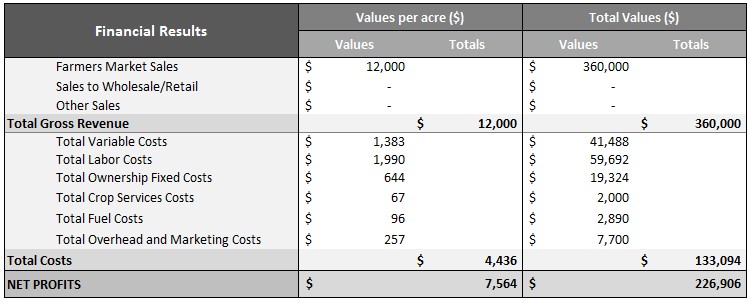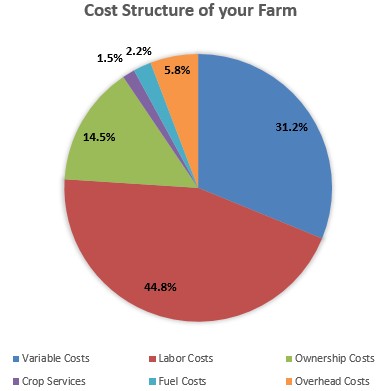Financial tools can help farmers improve farm’s performance and assure profitability. Enterprise budgets, financial statements, and sensitivity analyses are examples of financial tools that assist farmers on their decision-making.
Enterprise budgets are a reliable tool that help keep track of revenues and expenditures associated with a specific crop. Farmers using these budgets can estimate the net profits per area of production, and assess if this profit is enough money to achieve their profitability goals. Budget information can also help farmers determine the minimum quantity of produce they need to sell (breakeven yield analysis) and the minimum price (breakeven price analysis) they should charge to cover all costs. Overall, enterprise budgets can help farmers to provide a realistic projection of the income, expenses and profits of a new crop or enterprise.
Building the HortBusiness Calculator for Cantaloupes
Our team, at the Horticulture Business Extension program at Purdue University, is developing the HortBusiness Calculator. Our long-term goal is to help Indiana specialty crop growers increase farm productivity and profitability. We are currently testing a melon calculator to assist growers make informed decisions.
The HortBusiness Calculator is a spreadsheet that guides farmers on building an enterprise budget and provides financial reports such as cost structure, sensitivity, and breakeven analyses. The calculator aims to help melon farmers understand their cash flow needs and constraints. Having these values visible can assist farmers on their recordkeeping activities and on creating reliable financial assessments. Several universities offer enterprise budgets for different crops grown under various production systems (check our website for examples).
Melon enterprise budget
Budgets are designed and presented in many ways. In general, enterprise budgets have three main sections: revenues, expenses, and net profits.
Revenues: includes all the ways that farmers make money. Producers can sell melons directly to consumers (e.g. farmers markets, farm stand) or sell to wholesalers and retailers. Our tool asks farmers to input the melon sales done through different market channels with the respective quantity and average price.
Expenses: includes variable, labor, asset, crop services, and overhead costs.
Net profits: is the result of computing revenues minus expenses, which can be expressed as dollars per acre, square feet, or total cultivated area.
The five components of the enterprise budget
We organized our enterprise budget into five main components:
- Revenues and basic information includes sales, prices, and general information about the farm
- Total variable costs includes the amount of money spent on seeds, compost and other inputs whose value depends directly on the production activities
- Total labor costs sums up the season expenses on wages of all hired workers and asks farmers to estimate wages for unpaid labor
- Total fixed costs includes assets, crop services, and fuel costs
- Total overhead costs includes all other expenses not directly related to production, but that are essential to the operation of the farm. Examples of overhead costs are taxes, insurance, marketing costs and other costs
Total variable costs include costs that depend directly on the production activities. Variable costs are the seeds, transplants, tools, fertilizers, and other inputs such as the quantity of boxes farmers need to store, transport, and sell produce.
Labor costs are the costs of having people working in the farm and include those hired permanently, temporarily, or those unpaid family members. It is important that farmers keep track of all the labor hours dedicated to the production of melons, especially if they are growing other crops. We categorize labor costs further depending on the type of activity: pre-planting, pre-harvest, and post-harvest, so we can help farmers estimate the stages of production that are more (or less) labor-intensive. Examples of labor costs are preparation for land or high tunnel, soil tests, planting (pre-planting), transplanting, pruning, pest management (pre-harvest), harvest, packaging, and transporting (post-harvest).
Fixed costs includes expenses related to assets, crop services, and fuel costs that are directly related to the production of melon, but do not vary with the level of production. Below we provide breakdown of fixed costs:
- Ownership costs are the expenses farmers incur when buying fixed assets such as tractors, high tunnels, and machinery in general. These expenses occur whether the crop is sold or not. Because it is likely that farmers use fixed assets for multiple crops, our enterprise budget asks farmers to calculate the percentage of input dedicated to the production of melons. Our budget also accounts for expenses related to maintenance and annual insurance costs of fixed assets.
- Crop services costs are related to those services that farmers hire from other agribusinesses. Common crop services expenses are renting a tractor, a rototiller, or paying for a nutrient delivery system.
- Fuel costs. Owning a vehicle or a tractor is costly, not only because farmers purchase them, but also because of their usage. Our enterprise budget calculates fuel expenses by asking farmers to provide information on the fuel cost ($/gallon), fuel usage of the equipment (gallons/hour), and its use during the growing season (hours/season). In doing so, the enterprise budget gives the total amount of dollars farmers spent on fuel used by every machine or vehicle per season.
Overhead costs are similar to fixed costs, but they are not directly related to melon production. For example, telephone and Internet bills are important for the proper functioning of the farm business, but these payments occur if melons were harvested or not. Common overhead costs are electricity, marketing and advertising, and display materials.
Cost structure, sensitivity, and breakeven analyses
After farmers have added all sources of revenues and expenses, our enterprise budget will automatically calculate and summarize the financial information in the sheet called “Analyses”. Here, farmers can obtain the financial results, and cost structure, sensitivity, and breakeven analyses of their melon production. This section is key to assist farmers on their financial decision-making.
The financial results illustrates the revenues, costs, and profits per area and for the entire farm. Table 1 illustrates the financial results table per acre and for the total cultivated area with melons. This table illustrates an example of a farmer selling melons at the farmers markets: sales are $12,000 and total costs are $4,436. Thus, net profits are $7,564 per acre or $226,906 for the total area.
Table 1. Financial results for a melon operation.
The cost structure information helps farmers take an in-depth look at how they spent their money on each of the costs categories. Figure 1 shows the cost structure pie chart that allows farmers compare the proportion of variable, ownership, crops services, fuel, labor, and overhead costs. In our example, the farmer reported that labor costs accounted for almost 45% of the total costs. Other costs reported where variable costs (31.2%), ownership costs (14.5%), overhead costs (5.8%), fuel costs (2.2%), and crop services (1.5%).
Figure 1. Cost structure analysis.
The sensitivity analysis illustrates how changes in prices and yield may affect farm profitability. Table 3 illustrates how our calculator creates different scenarios to help farmers understand risk, make investment decisions, and act proactively in case of unexpected prices and production scenarios.
In this example, a farmer sells 8,000 melons per acre at $1.50 per unit, which generates $12,000 of gross revenues. His/her net profit of $7,563.52 per acre is calculated by the difference between gross revenues ($12,000) and total costs ($4,436.48). Table 3 illustrates how variations in prices and yield may affect net profitability. For example, if price decreases by 10% (from $1.50 to $1.35 per unit) and yield stays the same (8,000 melons per acre), net profits per acre decrease from $7,563.52 to $6,363.52.
Figure 3. Scenarios of the sensitivity analysis of the HortBusiness Calculator.
The breakeven analysis assists growers in computing the minimum price (breakeven price) and minimum yield (breakeven yield) that farmers need to achieve to be able to cover total costs (zero profits). Table 4 provides an example of the breakeven yield analysis. In this example, a farmer sells 8,000 melons per acre at $1.50 per unit, which generates $12,000 of gross revenues (see Table 1).
In the current scenario, at price $1.50 per melon and total costs of $4,436.48, the farmer needs to produce and sell at least 2,958 melons per acre to break even –cover total costs and have zero profits. The HortBusiness Calculator also combines breakeven analysis with sensitivity analysis to help farmers assess how changes in prices, yield, and costs can affect the farm profitability. For example, if prices decrease by 30% (from $1.50 to $1.05 per melon) and total costs per acre stay the same ($4,436.48), the farmer would need to sell at least 4,225 melons per acre to break even.
Table 3. Scenarios of breakeven yield analysis obtained from the HortBusiness Calculator.
Conclusions
This publication describes the components, use, and benefits of an enterprise budget. We are currently looking for Indiana melon farmers willing to test our tool and give us feedback. Your feedback will help us validate and improve our budget. For more information on testing the calculator, please contact Dr. Ariana Torres to torres2@purdue.edu or 765-494-8781.



